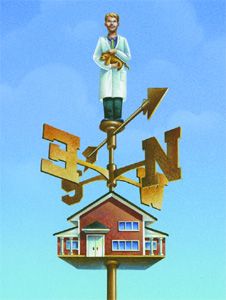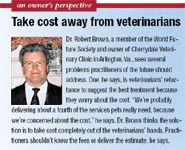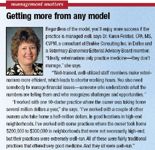The winds of change
For the 30 years I've been a veterinarian, I've heard we don't have too few doctors; we have too many veterinary hospitals," says Dr. Dennis Cloud, owner of Cloud Veterinary Center in St. Louis, Mo., and a Veterinary Economics Editorial Advisory Board member. While dramatic change is never an overnight event, the winds are blowing; Dr. Cloud's sentiments echo those of many in the veterinary profession, spurring the question: What practice models will define the future of the profession?
For the 30 years I've been a veterinarian, I've heard we don't have too few doctors; we have too many veterinary hospitals," says Dr. Dennis Cloud, owner of Cloud Veterinary Center in St. Louis, Mo., and a Veterinary Economics Editorial Advisory Board member. While dramatic change is never an overnight event, the winds are blowing; Dr. Cloud's sentiments echo those of many in the veterinary profession, spurring the question: What practice models will define the future of the profession?

"I don't think anybody knows what the definitive model of the future will be," says Dr. Cloud. "In the past, the model was fairly easy. A veterinarian said, 'I want to own and direct a three- or four-doctor AAHA-certified facility.' That was the dream." But with increasing focus on the growing complexity of practice—and the need for healthy life balance—it's no longer safe to say that's the dream for the majority of veterinarians.
While Dr. Cloud thinks well-located, dynamic, solo practices—niche hospitals—will persist, he sees a stronger trend toward consolidation. Within one mile of his latest practice, there are three other small animal practices—each technologically competent, practicing high-quality medicine, and well-managed.

An owners perspective: Take cost away from veterinarians
Dr. Cloud says he's certain profitability would improve if all four of these practices were working out of the same facility. The facility would achieve economies of scale and even greater technological competence, and it would be open 24 hours. "The idea is slowly evolving that if we have fewer buildings, we'll have greater profitability," he says.
Factors driving the changing model
A male graduate recently wrote Veterinary Economics with this provocative complaint about the quality of life for new members of the profession: "I'm rebelling against the business paradigm created by the previous generation of veterinarians, where the answer to everything is to work harder and work longer."
Strong words. While war stories of solo practice became legend in the formerly male-dominated profession, young female graduates in particular, and new graduates in general, aren't buying the wisdom of the 70-hour workweek. The 2002 Veterinary Economics Gender and Pay Study suggests the depth of gender dissatisfaction with the demands of a previous generation. Of the 446 female veterinarians responding, 63 percent thought raising a family would clash with the rigors of being a veterinarian, damaging their potential earning power.

Looking ahead: Issues future models should address
So does a practice model exist that will allow this new generation of doctors to practice high-quality medicine, enjoy a healthy personal life, and still make a good living? Dr. Karen Felsted, CPA, MS, CVPM, a consultant at Brakke Consulting Inc. in Dallas and a Veterinary Economics Editorial Advisory Board member, laughs a little at the question.
"Everybody wants to have it all," she says. "While new models are definitely possible, I don't think we're utilizing the old model to its fullest. And regardless of the model, you need to invest in a period of hard work before you start living the dream." (See "Getting More From Any Model".)
Of course, Dr. Felsted isn't unsympathetic to the need for a more sane work life. "It's not in anybody's interest to work 70 hours a week," she says. Yet, she continues, young associates should realize that most new professionals—in law, medicine, and accounting, to name just a few examples—"pay their dues" the first few years with long hours and six- and seven-day workweeks.

Management matters: Getting more from any model
Dr. Felsted believes, however, there are models that provide a healthy balance. "You may not be able to have it all," she says, "but you can have it better."
"If you say you want financial security, you're probably thinking about practice ownership or, at the least, very good salaries for associates," she says. "If you're talking about quality of life, you're talking about 40 to 45 working hours and a not-too-stressful work environment. Almost by definition, these requirements lead you to a larger practice—not a solo practice and probably not a two-doctor practice." Of course, a multi-doctor practice doesn't make sense in all locations; Dr. Felsted says the model she's talking about will likely be a small animal practice in an urban/suburban area.
Focusing on the right services is critical to helping you balance the equation. Dr. Felsted says shopped items, such as vaccinations, ovariohysterectomies, and neuters, generally generate less profit for the practice. "However, I don't recommend cutting the shopped stuff," she says. "If you limit that work—or you price it really high—eight years later when your current pet population is dead, you won't have a new generation of clients bonded to your practice. You meet clients when their pets are puppies and kittens and that's how they bond. Of course, you don't have to charge the low-end of the range for these services."
When it comes to high-end items such as ultrasounds and endoscopes, however, Dr. Felsted says practitioners need to choose carefully and work hard to educate clients. "Very few clinics really can make an endoscope profitable, but ultrasounds can be a great asset," she says. "Some pricey machines can be pricey toys unless you use them aggressively."
Wheel with spokes
One way for practices to run more smoothly is to streamline them—keep expensive equipment at a central hospital to which cases are referred from outlying wellness clinics. This model might look like a wagon wheel—a central referral hospital in the center surrounded by smaller general practices like spokes, says Dr. Felsted. Theoretically, the model would weave a community of veterinarians rather than practitioners being part of a crowded, competitive landscape.
This wheel-and-spokes model also catches Dr. Richard Timmins' eye. Dr. Timmins directs the Center for Animals in Society at the University of California Davis, where he's building a new academic program in family practice. He envisions a generation of graduates who interact with pets and their owners in a way that's reminiscent of the storied family doctor of the 1950s; veterinarians involved in the health and welfare of the family as a whole from before the pet is adopted to its final hour. These practitioners will also work closely with the community, serving as a resource for information about issues pertaining to animal well-being and the role of animals in society. "They'll work in outpatient clinics, doing general medicine, surgery, and routine exams, conducting risk assessments on new patients, counseling their clients, and doing life-stage health management," Dr. Timmins says.
As spokes in the wheel, those veterinary family practitioners would interact with individual referral practices or with a large, comprehensive referral hospital, either academic or private. He likens this interaction to "hospital privileges" in human medicine. The end result: Veterinary family practitioners could operate technologically streamlined clinics that provide both financial rewards and high-quality lifestyles.
Of course, for the wheel-and-spokes model to work, practitioners in independent practices need to see themselves and their businesses as part of a more collaborative pet healthcare system. Dr. Timmins raises another challenge: figuring out how to help clients pay for their pets' healthcare needs. "The success of any business model involving advanced medical and surgical veterinary care depends on the implementation of pet health insurance plans, savings accounts, low-interest loans, employee benefit programs, and other innovative approaches that will make optimal veterinary care affordable," he says.
The hub
The Veterinary Referral Center of North Texas is a Dallas facility resembling the hub Dr. Timmins and others imagine in the spoke-and-wheel model. It's a mega-practice comprised of smaller referral practices under one large roof. Dr. Joe King administers the facility, which opened in March of 2000 and is home to five different specialty clinics—dermatology, ophthalmology, internal medicine, radiology, and surgery.
"These clinics were originally scattered around town, and the owners thought maybe they could do away with the confusion when veterinarians made referrals," Dr. King says. "Plus, with a bigger facility, they could operate more efficiently."
Dr. King explains that the five clinics have completely separate staffs. A client walks into the lobby of the three-story building rather than into one of the clinics. Local veterinarians, he contends, think of the referral center as the gold standard in each of its specialties.
Maintaining a healthy alliance with local general practitioners is naturally a key element in the model. Dr. King says the clinics are careful to send every case back to the referring practitioner. "Let me put it this way," he says. "There's not a single vial of vaccine in the building. Losing clients just isn't a concern for the general practitioner."
How does this mega-practice of 21 veterinarians meet the lifestyle needs of its practitioners? "They work hard when they're here," Dr. King says, "but they have a decent lifestyle. There's always somebody on call. Some work a little longer than others. Some draw the line at 40 hours, which is hard to do in general practice. And if a specialist wants to work 30 hours a week, the practices can certainly arrange that."
The national practice
Banfield, The Pet Hospital's model focuses on providing many locations and standardized services and levels of care. With almost 500 hospitals in the United States, United Kingdom, and Mexico, the Portland, Ore.-based private practice will hire 350 veterinarians this year alone.
Yet that staggering number isn't the one that interests Dr. Scott Campbell, CEO of Banfield. More impressive, he says, is Banfield's turnover rate, which he estimates to be 13 percent. The practice's goal, he says, is 8 percent, similar to the target turnover rate in human care.
What does this model offer to keep turnover low? For one, says Dr. Campbell, the company invests in education and technology. "We spend more than $24 million educating team members and about the same on our systems every year."
Plus, the model offers veterinarians more flexible schedules. Banfield veterinarians can arrange to work from just three days every two weeks to five days a week—but they're encouraged not to work more than 45 hours per week.
This flexibility's an important part of Banfield's philosophy—and it's key to attracting practitioners to the model. "Ninety percent of the veterinarians we're attracting graduated from school in the past 12 years," says Dr. Campbell. "They're predominantly female, from white-collar families and city suburbs. They have kids, and, for the most part, they don't want to own a practice. Yet they want a leadership position. And they carry significant school debt. We've found these doctors want one thing—quality of life."
Dr. Campbell says "quality of life" means four things to these doctors. They want: to practice a quality of medicine they can be proud of, time off to spend with their own family and pets, to earn an income at least as good as other professionals, and to enjoy a financially secure retirement when the time comes. "And that time will be closer to 50 than to 70," Dr. Campbell says.
Banfield veterinarians earn an average of $94,000 a year, before profit-sharing benefits or retirement contributions, which is close to the national average of $94,720, reported in the 2004 AVMA-Pfizer Business Practices Study. And based on a Banfield study, Dr. Campbell says the veterinarians see more patients per day—an average of 19—than the average practice. He attributes the increase to the practice's computer systems, training, working model, and support staff.
Dr. Campbell says he thinks any blank sheet for the future starts first with the needs of pets and their owners, rather than the needs of veterinarians. He argues that one fuels the other: "We can't provide team members with a better quality of life if we don't give pets human-quality care. Clients won't pay for a better quality of life if we don't provide the care. The model of the future needs to address patients' needs first."
Perhaps the best model will be no model
Unlike Dr. Campbell, Dr. Robert Brown believes practitioners should think about future models in terms of what they want from practice. Thinking about the future is natural for Dr. Brown, who's a member of the World Future Society in addition to founding the Cherrydale Veterinary Clinic in Arlington, Va., 33 years ago. And the best model, he argues, may be the model you develop for yourself, based on your own needs and desires.
"I think you should start with the individual first—his or her personality, likes, dislikes, aptitudes, and financial requirements. Then devise a system that supports that veterinarian," he says.
Dr. Brown offers the dental profession as an example. Practice models for dentists are uniform, detailed, and rigid. The problem, he says, is that that kind of model requires a distinct personality for the practitioner to be happy and successful. "You'll feel like a failure if you don't make it in one of these established practice models when, in effect, practice models can't be mass produced," he says. In other words, one size just doesn't fit all.
"This is a wonderful profession, but at the same time, it can be maddening," Dr. Brown says. "Collectively, we do such wonderful work. But I see so many practitioners doing it in a way that leaves them fatigued, disgruntled, and burned out too early. They're stuck. They don't know what to do except work harder."
His solution: Get to know yourself better. Then devise an efficient system that meets your needs and leverages your talents. "Everybody wants a formula for success," he says. "It's harder to identify your own requirements, needs, and aptitudes. But if you can do that, coming up with a model that works for you is easy."
The bottom line
More than one model will likely define the veterinary landscape. Regardless of which one dominates-or even if none of them do—the trends theyâre addressing are clear: quality of life and the cost of running a business.
Special Assignments Editor John Lofflin is a freelance writer based in Kansas City, Mo. Please send comments or questions to ve@advanstar.com